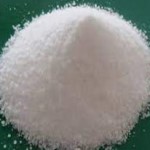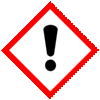Ammonium Chloride SDS of Suppliers Exporters, Manufacturers
Ammonium Chloride
CAS Number: 12125-02-9, Suppliers Exporters, Manufacturers

Please visit Main Page of Ammonium Chloride IP BP Ph Eur USP FCC Reagent Grade Manufacturers.
Ammonium Chloride SDS, Safety Data Sheet
MSDS Sheet 06-May-22
1. Product Identification
Product Name & Other Names: Ammonium Chloride or Sal ammoniac or Ammonium muriate or Salamaka or Salmiac or Muriate of Ammonia.
CAS No.: 12125-02-9
EINECS EC Number: 235-186-4
Relevant uses and uses advised against (if any) : Industrial use only.
Supplier: As per letterhead.
2.Hazards Identification
GHS, Globally Harmonized System Classification in accordance with 29 CFR 1910
Classification according to Regulation (EC) No 1272/2008
Acute toxicity, Oral (Category 4), H302
Eye irritation (Category 2A), H319
Hazardous to the aquatic environment, acute hazard (Category 3), H402
Labeling according to GHS USA & Regulation (EC) No 1272/2008
GHS Label Elements  Irritant |
Signal Words: Warning
Hazard statements:
H302 Harmful if swallowed.
H319 Causes serious eye irritation.
H402 Harmful to aquatic life.
Precautionary statements:
P262 Do not get in eyes, on skin, or on clothing.
P264 Wash skin thoroughly after handling.
P270 Do not eat, drink or smoke when using this product.
P273 Avoid release to the environment.
P280 Wear protective gloves/protective clothing/eye protection/face protection.
P314 Get Medical advice/attention if you feel unwell.
P301+P312 IF SWALLOWED: Call a POISON CENTER or doctor/physician if you feel unwell.
P305+P351+P338 IF IN EYES: Rinse cautiously with water for several minutes. Remove contact lenses, if present and easy to do. Continue rinsing.
P337+P313 If eye irritation persists: Get medical advice/ attention.
P330 Rinse mouth.
3. Composition/Information on Ingredients
Product Name & Other Names: Ammonium Chloride or Sal ammoniac or Ammonium muriate or Salamaka or Salmiac or Muriate of Ammonia.
CAS No.: 12125-02-9
EINECS EC Number: 235-186-4
4. First Aid Measures
Always seek medical attention after first aid measures are provided.
Inhalation: Remove to fresh air. If not breathing, give artificial respiration. If breathing is difficult, give oxygen. Get medical attention.
Ingestion: Induce vomiting immediately as directed by medical personnel. Never give anything by mouth to an unconscious person. Get medical attention.
Skin Contact: Immediately flush skin with plenty of water for at least 15 minutes. Remove contaminated clothing and shoes. Get medical attention. Wash clothing before reuse. Thoroughly clean shoes before reuse.
Eye Contact: Check for and remove any contact lenses. In case of contact, immediately flush eyes with plenty of water for at least 15 minutes. Cold water may be used. Get medical attention.
5. Fire Fighting Measures
Fire: Not considered to be a fire hazard. At fire temperatures ammonium chloride begins to corrode metals and may dissociate into ammonia and hydrogen chloride. Mixtures of about 16% to 25% (by volume) ammonia gas in air are flammable.
Fire Extinguishing Media: Use any means suitable for extinguishing surrounding fire. Water spray may be used to keep fire exposed containers cool.
Extinguishing Media Not recommended: Avoid using solid water jet as it may scatter the fire.
Special Information: In the event of a fire, wear full protective clothing and NIOSH-approved self-contained breathing apparatus with full face piece operated in the pressure demand or other positive pressure mode. At elevated temperatures under fire conditions, it may produce toxic or irritating fumes. Fire-extinguishing work is done from the windward and the suitable fire-extinguishing method according to the surrounding situation is used.
6. Accidental Release Measures
Personal precautions, protective equipment, and emergency procedures: Ventilate area of leak or spill. Avoid breathing dust/fumes/gas/mist/vapors/spray. Use individual protective equipment (waterproof boots, suitable protective clothing, safety glasses, etc.). Do not approach facing the wind.
Environmental precautions: Do not let the product enter drains, soil, or water sources.
Methods and materials used for containment cleanup procedures and Storage: Contain spilled material. Cover with an inert, non-combustible absorbent material, (e.g., sand, earth, diatomaceous earth, vermiculite). Vacuum or sweep-up and remove to an approved disposal container.
7. Handling and Storage
Precautions for safe handling: Apply according to good manufacturing and industrial hygiene practices. Ensure proper ventilation. Wash thoroughly after handling. Do not drink, eat, or smoke while handling. Avoid contact with skin, eyes, and clothing. Minimize dust generation. Avoid breathing dust/fumes/gas/mist/vapors/spray. Use individual protective equipment (waterproof boots, suitable protective clothing, safety glasses, etc.). Prevent any contact with hot surfaces.
Conditions for safe storage, including any incompatibilities: Store in cool, dry, and ventilated area away from heat sources and protected from sunlight in tightly closed original container. Keep air contact to a minimum. Store protected from heat, sparks and ignition sources and incompatible materials. Do not store with incompatible materials like strong oxidizing agents.
8. Exposure Controls/Personal Protection
Airborne Exposure Limits:
-ACGIH Threshold Limit Value (TLV): 10 mg/m3 (TWA); 20 mg/m3 (STEL) Fume
Ventilation System: A system of local and/or general exhaust is recommended to keep employee exposures below the Airborne Exposure Limits.
Personal Respirators (NIOSH Approved): If the exposure limit is exceeded and engineering controls are not feasible, a half face piece particulate respirator (NIOSH type N95 or better filters) may be worn for up to ten times the exposure limit or the maximum use concentration specified by the appropriate regulatory agency or respirator supplier, whichever is lowest.
Skin Protection: Wear impervious protective clothing, including boots, gloves, lab coat, apron, or coveralls, as appropriate, to prevent skin contact.
Eye Protection: Use chemical safety goggles and/or full-face shield where dusting or splashing of solutions is possible. Maintain eye wash fountain and quick-drench facilities in work area.
Other Control Measures: Maintain good housekeeping in work area. Handle in accordance with good industrial hygiene and safety practice.
9. Physical and Chemical Properties
Appearance: White crystals or powder or granules or tablets.
Odor: Not available.
Odor threshold: Not available.
pH: 5.5 (1% aq.sol.); 5.1 (3% aq.sol.); 5.0 (10% aq.sol.)
Relative density: Not available.
Boiling Point: 520C (968F)
Melting Point: 338C (640F) Sublimes
Flash point: No data found.
Auto-ignition temperature: No data found.
Decomposition temperature: No data found.
Upper/lower flammability or explosive limits: No data found.
Vapor Density (Air=1): 1.9
Vapor Pressure (mm Hg): 1.0 @ 160C (320F).
Evaporation rate: No data found.
Flammability (solid, gas): No data found.
Partition coefficient: n-octanol/water: No data found.
Solubility(ies): No data found.
Viscosity: No data found.
Molecular Weight: 53.49
Chemical Formula: NH4Cl.
10. Stability and Reactivity
Stability: Stable under ordinary conditions of use and storage.
Hazardous Decomposition Products: Decomposition forms hydrogen chloride and ammonia.
Hazardous Polymerization: Will not occur.
Incompatibilities: Concentrated acids, strong bases, silver salts, potassium chlorate, ammonium nitrate, bromine trifluoride and iodine heptafluoride. Ammonium Chloride reacts explosively with potassium chlorate or bromine trifluoride, and violently with bromide pentafluoride, ammonium compounds, nitrates, and iodine heptafluoride. Explosive nitrogen trichloride may result from reaction of ammonium chloride and hydrogen cyanide.
Conditions to Avoid: Heat, moisture, incompatibles.
11. Toxicological Information
Oral rat LD50 : 1650 mg/kg Investigated as a mutagen.
Carcinogenicity: No component of this product present at levels greater than or equal to 0.1% is identified as probable, possible, or confirmed human carcinogen by IARC.
Mutagenic Effects: No data found.
Teratogenic Effects: No data found.
Developmental Toxicity: No data found.
Reproductive Effects: No data found.
12. Ecological Information
Toxicity to fish:
LC50 - Cyprinus carpio (Carp) - 209,00 mg/l - 96 h
LC50 - Oncorhynchus mykiss (rainbow trout) - 3,98 mg/l - 96 h
NOEC - Oncorhynchus mykiss (rainbow trout) - 57 mg/l - 96 h
Toxicity to daphnia and other aquatic invertebrates: LC50 - Daphnia magna (Water flea) - 161 mg/l - 48 h
Results of PBT and vPvB assessment: This substance/mixture contains no components considered to be either persistent, bioaccumulative and toxic (PBT), or very persistent and very bioaccumulative (vPvB) at levels of 0.1% or higher.
13. Disposal Considerations
Whatever cannot be saved for recovery or recycling should be managed in an appropriate and approved waste disposal facility.
14. Transport Information
DOT USA, TDG Canada & ADR/RID Europe: Not controlled.
IMDG/IMO & IATA/ICAO: Not controlled.
15. Regulatory Information
USA:
SARA 311/312: See section 2.
California No Significant Risk Level: None of the chemicals in this product are listed.
16. Other Information
Disclaimer:*************************
Our company provides this SDS information sheet contained herein in good faith but makes no representation as to its comprehensiveness or accuracy. This SDS sheet is intended only as a guide to the appropriate precautionary handling of the material by a professionally trained person using this product. Individuals receiving the information must exercise their independent judgment in determining its appropriateness for a particular purpose.
*************************
Please visit Technical Data Sheet of Ammonium Chloride IP BP Ph Eur USP FCC Reagent Grade Manufacturers.
Ammonium Chloride CAS Number 12125-02-9 & Ammonium Sulfate CAS Number 7783-20-2 Supplier Exporter, Manufacturer:
Annie Chemie P Ltd
Mumbai 4000010, INDIA
With Agents and offices in UAE, USA, Europe.
e-mail: info@anniechemie.com
Copyright and Usual Disclaimer is Applicable.
May 29, 2025
Exporters to USA, Canada, UK, Europe, UAE, Nigeria, Algeria, Turkey, Mexico, Brazil, Chile, Argentina, Australia, Dubai etc.
Perfection is made up of small things and that is a big thing.
